Information on
authentic Medieval Pavilions from
House Greydragon
Here are some photos of an existing pavillion that is on display at the Historical Museum
(Barfüsserkirche) in Basel, Switzerland. I got the opportunity to caress and
fondle the pavilion. (I tried hard to keep all the drool on my sleeve...)
According to the museum, the tent was made in the first half of the seventeenth
century, (before 1655 for sure because records from 1655 indicate it being in existence
for several years), but they are not sure of the exact year of creation. The tent
belonged to one of the guilds of Basel, which is called The Golden Star. It seems that all
the guilds used them for different purposes: events, in the war (to take care of wounded
soldiers), etc.. The museum got the tent in 1889 directly from the Guild. The ropes
and center pole are not original. According to the curator, the rope
"hooks" (which attach the ropes to the grommets around the rim of the tent) are
original. All the photos are thumbnails, so you can choose whether or not to
view the larger picture. I have provided the size of the large photo. I have not
resized any of the large photos because I wanted you to be able to see some of the very
fine details, so many of them are 1800 pixels wide.
 |
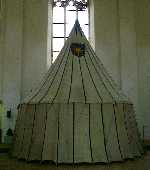 |
| Standing on the balcony above the tent. (46 KB) |
A poor lighting side shot. (I didn't realize
how much light was coming throught the window into the lens of the camera.) (97 KB) |
Several things about this pavilion:
- It is NOT a hub and spoke design. It is supported by a single pole and
intended to be held out by the ropes (in a crow's foot fashion). In the
museum it has an internal structure which they use for displays inside the pavilion and
convenience of not having to have the ropes spread out in the museum.
- The walls are attached (stitched) to the roof
- The colored lines are stitched on. On the roof, the blue canvas is
stitched over every seam. On the wall pieces, because the seams are farther apart,
there is an extra color line attached midway between the seams
- On each seam, the colored line was stitched into the seam. This is clear
on the inside where you can clearly see blue stitching on one side of the seam, but not on
the other side (meaning left side and right side, not inside and out).
- The fancy finial is removable from the "cap". They had several
other finials hanging on the wall.
- The roof cap was made of leather, studded and had a metal band with attachment
points for 3 "high-wind ropes".
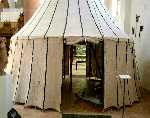 |
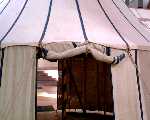 |
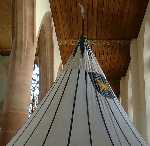 |
| The opening of the pavilion showing the (fake)
internal structure and the center pole (131KB) |
The opening, with a closer image of the rolled up
door. (71KB) |
View of roof showing roof cap and finial. You
can faintly see one of the high wind ropes on the right side. (64KB) |
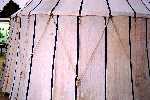 |
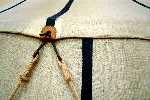 |
 |
| Side wall of tent showing each rope attached to
three places (in crow's foot style) (156KB) |
Closeup showing two crow's feet attaching to same
location (142KB) |
Closeup of crow's foot knot. (173KB) |
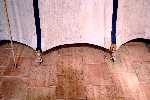 |
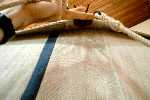 |
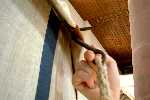 |
| Closeup showing leather grommets for stake loops,
as well as repair (162KB) |
Closeup underneath the flap showing the wall
attached to the roof, as well as grommet repair (123KB) |
Another closeup underneath the flap (109KB) |
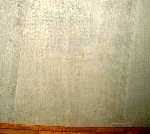 |
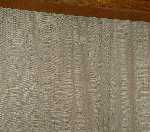 |
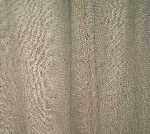 |
| Can't see in the thumbnail. This shot shows two
seams on the inside of the roof, and shows the clear stitching of the color line on one
side of the seam (110KB) |
Can't see in thumbnail. This shot shows a
small repair and the color line stitched on between the seams of the side wall, as
evidenced by the two rows of colored stitching. (163KB) |
This shot shows the inside of a side wall seam.
The seam is very hard to see but is to the left of the colored stitching. (108KB) |
 |
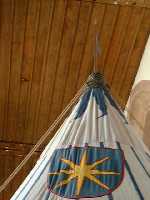 |
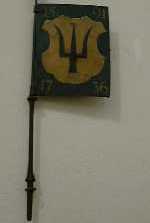 |
| Close up of another roof cap (from 1661), showing
the metal band and ring attachment points for high wind ropes (56KB) |
Shot of the roof cap showing two of the three high
wind ropes (28KB) |
One of two or three finial spikes that was hanging
on the wall. It appears that the finials were removeable and exchangeable.
This finial was used in 1591 and 1736 (presumably on another tent). (23KB) |
Return to pavillion page.



